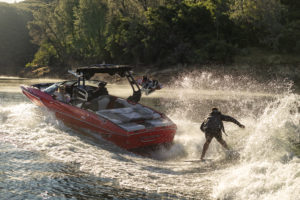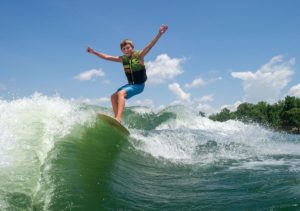Freedom—July 14, 2020—Members of the state’s Commission to Study Wake Boats reached consensus on several measures to improve boater safety, but disagreed on whether there should be limits on where wake boats can be operated.
The legislature authorized formation of the Commission last year after receiving complaints that wake boats were creating safety hazards and causing environmental issues. The 15-member commission included state officials, lake property owners and members of the water sports industry who spent nine months processing technical data and collecting anecdotal information.
Wake boats are designed or modified to take on enough ballast to lower the stern and displace more water than a typical powerboat. The sport of “boarding” has two styles—wakeboarding and wakesurfing—both of which rely on having a boat that can create a very large wake.
In its summary report, issued last week, the Commission recommended that wake boat operators be required to have an observer onboard and ensure that boarders are wearing a life jacket. It also agreed that “wakesurfing” should be given a definition in RSA 270-D:1, which defines basic boating terms including “waterskiing” and “headway speed.”
But the Commission was divided on whether the public should be allowed to petition the state to limit wake boat use in specific areas on a case by case basis. It also failed to reach agreement on whether to establish statutory criteria to define “wake boats,” “tow boats” and “ballast boats,” which would be a prerequisite for regulating such watercraft, and took no action on recommending how to address the spread of microscopic particles of invasive species that ‘hitchhike’ from lake to lake in ballast tanks.
Despite its limited actionable recommendations, the Commission’s report provides a valuable compendium of information about wake boats that did not exist a year ago.

Online ad for Supreme Boats, one of many companies specializing in wake boats.
The report’s evaluation of scientific data—including water turbidity, bank slope characteristics and wave dynamics—makes for dense reading. But the report is clear on one point: waves from wake boat have the potential to be larger and more powerful than those created by other watercraft of similar size and shape.
Research sponsored by the Water Sport Industry Association (WSIA) in 2015 found wave heights for wakeboarding were 43% higher than when the same boat was cruising and not towing a boarder. Waves for wakesurfing were 114% higher, using the same comparison.
In regard to wave energy (discussed in detail in the report) the WSIA study found waves from wakeboarding generated 179% more wave energy than waves from the boat when cruising, and 720% more energy for the same boat when wakesurfing.
Commission members favoring legislation say the industry’s own scientific data shows wake boats are not suited to all bodies of water. They believe the public should be allowed to petition to have wake craft use limited under certain circumstances, such as when shoreline erosion is inevitable, and in areas where they pose a threat to swimmers, smaller watercraft and loon nests.
“It seems incompatible with all but the center of our largest lakes that such a large swath of water would be taken by one boat and all the rest would have to cope,” per the report.
Wake boat proponents don’t deny the science or the potential negative impact the boats can have. But they believe education and voluntary changes in boater behavior are the best ways “to foster a peaceful environment on all waterways.”
Trade industry guidance for boaters, such as this video, acknowledge complaints about wake boats by recommending limiting the number of repetitive passes along residential shorelines, keeping music at reasonable levels, and staying 200 feet from shorelines, docks and other boats. (State law requires 150 feet of distance).
 Proponents also point out that wake boats are popular, bring vacationers to our lakes, and fill coffers in a state that is among the top ten in its reliance on outdoor recreation revenue.
Proponents also point out that wake boats are popular, bring vacationers to our lakes, and fill coffers in a state that is among the top ten in its reliance on outdoor recreation revenue.
In a letter to the Commission, the Lakes Region Tourism Association wrote that “establishing limitations or regulations on wake boats…would put an added burden on the economy during an increasingly difficult time.”
Reasonable Use
The state’s public trust doctrine frames the wake boat debate. As it pertains to lakes, the doctrine seeks to balance competing uses between shorefront property owners and the public. This balancing act is rooted in the concept of “reasonable use.”
When competing lake uses come into conflict, the Department of Safety Services can seek a “reasonable use” outcome using a structured hearing process. The structured hearing process helped resolve conflicts between jet ski operators and shorefront property owners in the late 1980s when such watercraft were new and controversial.
As a result of hearings, jet skis were prohibited from some bodies of water, and on others were ordered to operate no closer than 300 feet from shore rather than the standard 150 feet. The combination of targeted regulations and manufacturing changes to the watercraft worked, and today there are few conflicts between operators and property owners, according to the report.
Proponents of legislation for wake boats believe a similar process could bridge the gap between wake sports enthusiasts and those concerned about their impact by identifying where wake boats can be operated safely and without creating environmental damage.
“It would also allow for industry recommendations to become law (no towing within 200 feet of shore) that otherwise would be ignored for lack of consequences,” per the report.
Those opposed to allowing such regulation say many types of boats can create large wakes under certain circumstances, not just wake boats.
Moreover, they say, local control will result in “piecemeal regulation” and create a process that “pits neighbor against neighbor and promotes long term animosity” while “reducing the value of a boater’s investment.”

If there’s an issue with erosion which is directly attributed to these ballast boats, and no action is taken, we need to follow the money.
I agree 100% with you Steve…Doesn’t take rocket science to see the possible damage that could happen to shore line properties…the commission needs to take a boat ride,and see for themselves..
While an improvement this is basically all talk, and no action. Once again the burden and responsibility for action is dependent on those who have property on the lake, and not those who come and use the lake for recreational purposes. This is similar to sandbar and other environmental issues such as invasive plants.
I basically read this as, “lets decide to do nothing, and maybe it will go away” It’s crazy the way our state has decided, revenue always comes first. This is a dangerous downhill path, that will eventually change the landscape of our lake forever.
Definitely a problem on Ossipee and other Lakes Region bodies of water, both in terms of shoreline erosion and the beating that is taken by boats and docks moored or tied up along the shoreline. Also note that boat wakes can amplify when the coincide. Without getting into detail, when two small wakes amplify, they result in a large wave. When two large wakes, as from wake boats, amplify, the resulting waves can be enormous–something I’ve observed repeatedly.
I have never heard the loons so vocal as I have this summer, and unfortunately they seem to be in distress, does anyone agree? The boat traffic is unlike any I have ever experienced in the 60 years I have been here. I dont know how any lake can survive when there seems to be no limit on how many boats and what kind are allowed? I am surprised there have not been more accidents. How can a boat warden even have a handle on it all. Its just crazy out there.
I absolutely agree with Debbie. There are way too many boats on Ossipee Lake and the weekends are now Friday, Saturday and Sunday. Trash is washing up on shore, weeds are spreading, shorelines are eroding. I will sign any petition that helps protect our lake and the loons.
We have also noticed the loon distress.
It’s too bad that the Commission doesn’t act on the devastation to the lake to preserve it for future generations. Way too many boats on the lake on weekends.
The quality of life on this lake has headed downhill fast. We have had more beach erosion in the last five years than the previous 40 years that we have been here. The wake boats, ski boats and tube pulling boats have turned Broad Bay into an ocean with the waves that wash ashore. You can’t swim any more unless you like swimming at the ocean.
The loons are in distress. Boats almost hit them since drivers are not paying nor do they keep their distance from them. Also the fish must under distress as the water clarity is terrible on weekends. It is not clear even 50-60 feet from shore.
The number of boats on the lake has increased. dramatically as well as the horsepower on them.
We think there should be a no wake speed limit if the water level rinses 4 or 6 inches above normal. Hopefully the new dam will help control the level better.
I’ve owned my lakefront property on one of the bays for over 20 years. This year has been unlike any previous year. The number of boats has skyrocketed, and wake-surf boats, at $100k plus, have quickly become THE prestige boat now…the Bentley or Maserati of the lake boating world. With huge weight, horsepower, and large, highly amplified stereo that is heard clearly across the lake, have changed the whole atmosphere of “lake life.” I’m all for having fun, and my own 1996 ski boat can also be used for wakeboarding. However, as I watch the giant waves from the new ballasted wake-surf boats crash over my dock, my boat, my Disappearing beach, and into the bushes and trees along the shoreline, it’s easy to see that the organic material from the shore is being washed into the lake, which settles on the bottom making the water more shallow, and making the bottom more mucky and less sandy. This has resulted in a big increase in weeds, which then create more organic material to sink to the bottom, and nourish even more weeds. It’s a viscous circle which can greatly accelerate the conversion of clean bays into swamps.
I don’t think anyone wants Ossipee Lakes. Bays to turn into swamps.
It’s going to take education and persistence to make changes necessary to turn things around. Not just long, boring meetings or heated, emotional discussions that accomplish nothing. .
These sports are created by an un-natural situation and therefore should be conducted in a environment created for just that activity. Simply, you don’t play golf at a park. You play golf at a golf course not a picnic area. Like wise so many other activities that require a special environment that environment is created or designed for the activity. Tennis, basketball, skiing so many more are in this category. But wake anything is on a much larger scale in an environment that involves many others individuals that also interferes with those others. Somehow that environment needs to be created possibly by designing an area on the larger lakes using a barrier to reduce the wave outside of the barrier.